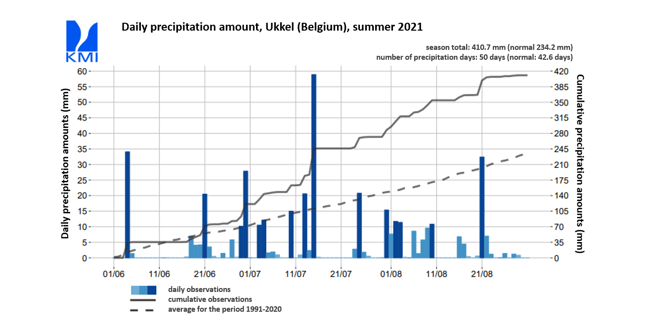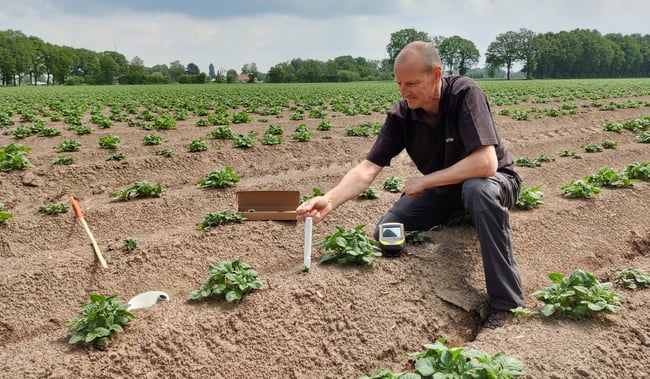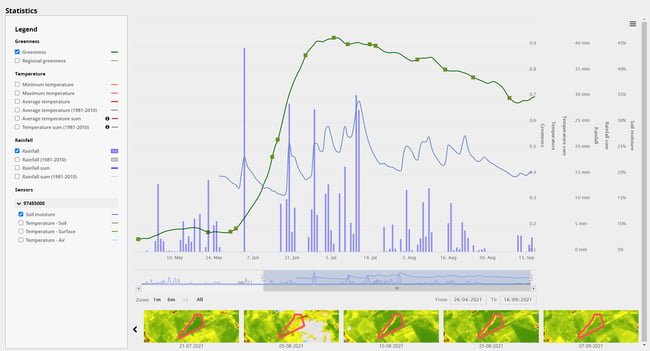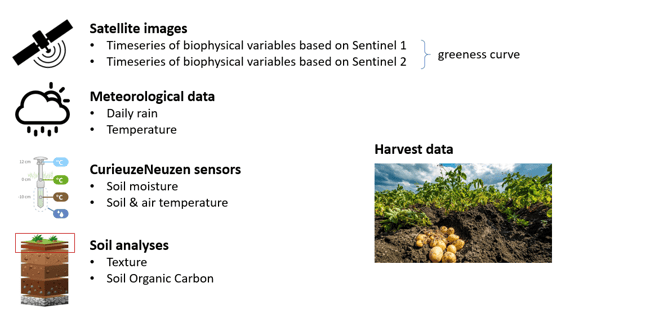Citizen science on drought! Wait, what?
In spring 2021, ‘CurieuzeNeuzen in de Tuin’ was kicked off. Led by the University of Antwerp and De Standaard, this massive citizen science project wants to gain insight in the microclimate and measures to which extent our gardens, public green spaces, and agricultural fields are susceptible to heat and drought. Expecting again a dry and hot summer season, 5000 “gazondolken” or “lawn daggers” were installed to measure the temperature and soil moisture between April and October 2021. But … the summer of 2021 will be remembered as the wettest summer ever in Belgium. What does this mean for a citizen science campaign on heat & drought?
Sentinel-1 satellite images of 9 and 15 July 2021 clearly show the effects of the exceptional rainfall.
The meteorological observations tell the story of this summer. We had to cope with intense and heavy rainfall. After a warm and dry onset during the first two weeks of June, the weather pattern drastically changed. Pouring rain was on the menu almost every week, with regularly days of more than 15 mm. In Brussels, the Royal Meteorological Institute recorded 410 mm of rain during the meteorological summer (June-Aug) while the average is only 234 mm. But there were also major regional differences. As we all know, the South-east of Belgium suffered from extreme rainfall, leading to catastrophic floods, while the North of Belgium experienced rather normal weather conditions.

Daily amount of rain in Brussels during the summer of 2021.
500 soil and temperature sensors in various fields
Within the CurieuzeNeuzen project we’re not only looking to private gardens and public green spaces, we’re also gathering data on fields to learn more about the impact of extreme weather, either dry or wet, on our agriculture. In June 2021, at the start of the growing season, we installed almost 500 sensors in 295 potato fields spread over Flanders. Additionally, we installed 30 sensors in orchards (pear, strawberry, blueberry and vineyard) as a side experiment.
 Installation of 500 soil and temperature sensors in several potato fields spread over Flanders.
Installation of 500 soil and temperature sensors in several potato fields spread over Flanders.
Why do we focus on potatoes? Not only because it’s the favourite crop of many Belgians. The potato plant is also highly susceptible to extreme weather. Most potato varieties cultivated in western Europe prefer air temperatures between 20-25°C and soil (root) temperatures between 15-20°C, while the soil is preferably moist but not too wet. On average, Flanders is blessed with these moderate weather conditions. However, periods of drought, heat waves, or excessive rainfall, can all impact the quality and quantity of the yield.
Thanks to the highly professional know-how throughout the entire chain, constant innovation and a detailed quality system to ensure excellent potato quality, the Belgian potato industry plays a significant role in the Belgian economy. Belgium is for example the largest exporter of processed frozen potato products in the world. Being able to anticipate and to respond to changing weather conditions in order to guarantee the availability of potatoes is therefore utmost important.
The effect on the cultivation of potatoes
This summer the major threat for the potato cultivation was the combination of persistent high humidity and moderate temperatures, resulting in severe disease stress. Late blight, Phytophthora and Alternaria were widely observed. Erosion gullies and difficulties to access the field with heavy machinery were other problems farmers faced. However, regular precipitation and moderate temperatures result also in favourable growing conditions. After a cold start in the spring with initially low yield predictions, a period of rapid growth followed in June and July. As a result, the expected potato yields are still more or less at the level of the multi-year average, as shown by samples taken by FIWAP / Carah in Wallonia and Inagro / PCA in Flanders between 6 and 8 September 2021 for the storage varieties like Fontane and Challenger.
But high quantity doesn’t always mean good quality. On the contrary, the quality will be inferior on many fields this year. The large amount of precipitation, often in combination with the presence of a lot of nitrogen in the soil, caused an explosive growth of the tubers, resulting in growth cracks and hollowness, mainly with Fontane. Some Fontane plots even started to flower again indicating new leaf and tuber growth. This will result in immature tubers. Where the ridges were washed away by runoff we see lots of green tubers. Quality checks during storage will be extremely important to timely detect rotten tubers and avoid losing large quantities.
Ready to analyze the sensor data
Unlike the measurements of the sensors in private gardens and public green spaces, which are collected and visualized in a personal dashboard, the measurements in the potato fields are stored in WatchITgrow, our online platform supporting growers to monitor their crops in view of increasing yields in a sustainable way. WatchITgrow allows combining remote sensing data with in-situ data using big data analytics and machine learning to provide growers with more timely and personalized advice.
Looking at the sensor measurements we already see that these low-cost devices were able to capture very precise and accurate measurements. Growers can easily access the soil moisture and soil temperature data, next to already available satellite images, greenness derived from Sentinel data, rainfall and temperature data.
 Evolution of the greenness (fAPAR based on Sentinel 1 & 2 > CROPSAR technology) of a potato field in the North of Belgium, indicated in green. Daily amount of rainfall shown in blue bars, and the soil moisture as measured by the CurieuzeNeuzen sensors indicated with a blue line.
Evolution of the greenness (fAPAR based on Sentinel 1 & 2 > CROPSAR technology) of a potato field in the North of Belgium, indicated in green. Daily amount of rainfall shown in blue bars, and the soil moisture as measured by the CurieuzeNeuzen sensors indicated with a blue line.
Once the harvest is over we will collect all sensors and start a detailed analysis of all measurements. Our remote sensing experts will combine all sensor data and link the soil sensor time series and soil properties measured in the field with:
- meteorological observations
- the greenness of the vegetation derived from satellite images
- soil properties derived through soil sampling
Time series analyses of satellite derived greenness and soil sensor measurements will elucidate factors contributing to crop development and performance during the season. Machine learning methods will be applied to realize multivariate time series forecasting in aid of yield estimation.

The temperature and soil moisture data captured by the CurieuzeNeuzen sensors will be combined with satellite data, meteorological observations and soil analyses to assess crop performance and harvest.
This will yield insight in the crop development and crop quality during the extreme weather conditions we experienced. Although the prime objective of CurieuzeNeuzen was to measure the impact of heat and drought on the cultivation of potatoes, also the impact of extreme precipitation is very relevant as projected to occur more often in the future. First results of this analysis will be shared the beginning of 2022. Stay tuned!
---------------------------

 ‘CurieuzeNeuzen in de Tuin’ is an initiative of the University of Antwerp and De Standaard, in close collaboration with Rabobank, Orange, VITO, VMM, Department of Economics, Science and Innovation, Department of Environment, Bio-Planet, DPD and Aquafin.
‘CurieuzeNeuzen in de Tuin’ is an initiative of the University of Antwerp and De Standaard, in close collaboration with Rabobank, Orange, VITO, VMM, Department of Economics, Science and Innovation, Department of Environment, Bio-Planet, DPD and Aquafin.
The agricultural experiment coordinated by several potato growers in collaboration with Agristo, Inagro, PCA, ILVO, Clarebout and Hooibeekhoeve. Measurements are collected and visualized in WatchITgrow, the plaform for digital crop monitoring.


.png)
/Blog_WorldCereal_1200x650.png)
/lewis-latham-0huRqQjz81A-unsplash.jpg)
/background_image_blog.jpg)